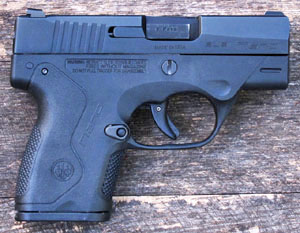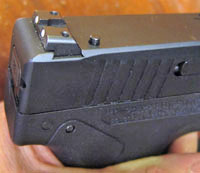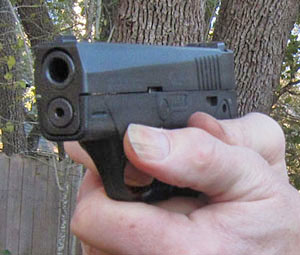|
The Beretta Nano
by Ed Buffaloe
 The Nano BU9 seems very Glock-like, particularly since I am well acquainted with the sub-compact Glock 27. It has the same little trigger safety lever that the Glock has, which
prevents the gun from firing if it is dropped. Like the Glock, the Nano is a locked-breech, striker-fired, double-action only pistol with no manual safety (other than the
trigger lever). The right-side external extractor and left-side ejector are nearly identical to those on the Glock, as is the breech lock mechanism and the double recoil spring.
Unlike the Glock, the Nano has no slide lock release lever, though the slide does lock open after the last round is fired. The Nano is smaller and slimmer than
the Glock and fits my hand better. The Nano slide is beveled on the sides instead of being “slab-sided,” so it seems much less blocky than the Glock. The Glock is unapologetically ugly, while
the Beretta manages to look at least a bit more stylish. The Nano BU9 seems very Glock-like, particularly since I am well acquainted with the sub-compact Glock 27. It has the same little trigger safety lever that the Glock has, which
prevents the gun from firing if it is dropped. Like the Glock, the Nano is a locked-breech, striker-fired, double-action only pistol with no manual safety (other than the
trigger lever). The right-side external extractor and left-side ejector are nearly identical to those on the Glock, as is the breech lock mechanism and the double recoil spring.
Unlike the Glock, the Nano has no slide lock release lever, though the slide does lock open after the last round is fired. The Nano is smaller and slimmer than
the Glock and fits my hand better. The Nano slide is beveled on the sides instead of being “slab-sided,” so it seems much less blocky than the Glock. The Glock is unapologetically ugly, while
the Beretta manages to look at least a bit more stylish.
The Nano has a different lockwork mechanism than the Glock, but the end result is quite similar. A connector bar on the right side of the gun connects the trigger to the sear. The disconnector is of
traditional design--a projection on top of the connector bar which pushes the bar down and out of engagement with the sear when the slide is out of battery. Working the slide causes the striker to
engage and hold the sear in a half-cock position. When you pull the trigger the sear rotates backward, pulling the striker even further back and then releasing it. If the sear does not hold the
striker at half-cock, the gun cannot be fired.
 The Nano is completely safe to carry with the striker in the half-cock
position. Beretta included a pin to block the inertial striker as an additional safety. As the trigger is pulled and the sear rolls backward,
the pin safety is pushed upward and out of engagement with the striker. The striker is only free to impact the primer when the trigger is all the
way to the rear. The striker block pin actually rises out of the top of the slide just in front of the rear sight--why Beretta made it do this I don’t
know, since its being visible serves no useful purpose--the shooter can’t see it because it is hidden by the rear sight, and it would just be a distraction anyway. The
Nano also has a striker deactivation button on the right side of the gun which allows the striker to be released from half-cock without pulling the trigger. This enables disassembling the gun without
the need to pull the trigger. The Nano is completely safe to carry with the striker in the half-cock
position. Beretta included a pin to block the inertial striker as an additional safety. As the trigger is pulled and the sear rolls backward,
the pin safety is pushed upward and out of engagement with the striker. The striker is only free to impact the primer when the trigger is all the
way to the rear. The striker block pin actually rises out of the top of the slide just in front of the rear sight--why Beretta made it do this I don’t
know, since its being visible serves no useful purpose--the shooter can’t see it because it is hidden by the rear sight, and it would just be a distraction anyway. The
Nano also has a striker deactivation button on the right side of the gun which allows the striker to be released from half-cock without pulling the trigger. This enables disassembling the gun without
the need to pull the trigger.
According to the manual, the frame of the Nano is made of “fiberglass reinforced technopolymer.”
There are little dimples on either side of the frame, just above the bow of the trigger guard--this is where the thumb of the off-hand goes when you use the thumb-pointed-forward two-hand grip.
Another pair of dimples at the base of the grip allow for easier magazine removal. All the edges are rounded slightly, the sights are low-profile, and there
 |
 |
|
Glock 27
|
|
|
|
are no projecting levers of any kind to snag on clothing. The gun is clearly designed for concealment. The only negative feature I would note on the Nano is the
shortness of the grip. Glock has designed their grip frame to allow the shooter to grip the gun higher up toward the bottom of the slide, allowing not only a better grip but also better recoil
control--I wish Beretta had done the same. Interestingly, a reader, Steven Kimmerly, wrote and said he thinks the Nano was designed to be used as a point and shoot gun and the lower
grip allows the gun to be easily fired using the middle finger.
The serial number is on the internal metal chassis, visible through a little window on the left side of the frame. Beretta
went one better than the competition--with their interchangeable grip straps--by making the entire frame of the Nano interchangeable. The technopolymer frame can be replaced in a matter of a few
minutes. There is only one frame style available now, at the start of production, but we assume that other configurations may become available later. The magazine release button is reversible,
making the Nano fully ambidextrous. The slotted disassembly pin on the right side rotates a quarter turn to release the slide for field stripping.
The Nano magazine holds six rounds. Supposedly, seven and eight round magazines will also be
available in future. There is no magazine safety, so the gun can be fired without the magazine. The manual says that the gun will be available in .40 caliber S&W and 9x21 IMI as well, but right now
only the 9mm Parabellum version is being sold. The Nano’s manual is very complete--it even gives detailed instructions on how to remove the subframe. Beretta warns that dry firing the gun
may result in damage to the firing pin, so they recommend the use of “snap caps.” However, my personal suspicion is that Beretta is simply trying to reduce the likelihood of lawsuits, and that is
the same reason they installed the striker deactivation button.
The left side of the slide reads, in lower-case sans-serif characters, toward the front:
--BERETTA USA CORP.--
ACCOKEEK MD PATENTED
above the trigger is the Beretta Logo and the word BERETTA in all capital serif characters.
On the right side of the slide in sans-serif characters is BU9 Nano and MADE IN USA. On the left side of the frame is READ MANUAL / BEFORE USE, and on the right side of the frame is WARNING; RETRACT SLIDE TO SEE IF LOADED / FIRES WITHOUT MAGAZINE / DO NOT PULL TRIGGER FOR DISASSEMBLY.
Field Report and Subjective Impressions
 So far the Nano has been 100% reliable with all kinds of ammunition. There is no mention in the manual of a break
-in period for the gun to feed and eject reliably, as is found with some other sub-compact 9mm pistols. I had no trouble keeping all the rounds on a paper plate at ten yards,
and with a little discipline three-inch groups are perfectly reasonable. The trigger pull is not as smooth as my Glock 27, but it is better than my Kel-Tec PF-9 or my Ruger LC9.
(I like all the features of the Ruger, except its long trigger pull.) The Nano is slightly thicker than either the Kel-Tec PF-9 or the Ruger LC9, but slightly smaller in length and
height. Neither the Kel-Tec nor the Ruger is rated for continuous use with +P ammunition, but there are no such restrictions on what the Nano can shoot. The Nano is heavier than the Kel-Tec
or the Ruger, but this is an advantage with +P ammunition. I could wish that the Nano had a 7-round magazine, but I assume that Beretta decided the extra round was worth sacrificing for a
smaller size, and hopefully larger magazines will be available later. So far the Nano has been 100% reliable with all kinds of ammunition. There is no mention in the manual of a break
-in period for the gun to feed and eject reliably, as is found with some other sub-compact 9mm pistols. I had no trouble keeping all the rounds on a paper plate at ten yards,
and with a little discipline three-inch groups are perfectly reasonable. The trigger pull is not as smooth as my Glock 27, but it is better than my Kel-Tec PF-9 or my Ruger LC9.
(I like all the features of the Ruger, except its long trigger pull.) The Nano is slightly thicker than either the Kel-Tec PF-9 or the Ruger LC9, but slightly smaller in length and
height. Neither the Kel-Tec nor the Ruger is rated for continuous use with +P ammunition, but there are no such restrictions on what the Nano can shoot. The Nano is heavier than the Kel-Tec
or the Ruger, but this is an advantage with +P ammunition. I could wish that the Nano had a 7-round magazine, but I assume that Beretta decided the extra round was worth sacrificing for a
smaller size, and hopefully larger magazines will be available later.
I bought the Nano because I wanted to be one of the first to offer holsters for it. I didn’t really
anticipate liking it, but I do. I thought the grip would be too short for me to be comfortable shooting it--I can only get two fingers around the grip--but I found to my surprise that the gun feels
very natural in my hand and shoots rather well. This is somewhat subjective, and I suspect that guys with large hands may not be as comfortable with the Nano. To me the gun just feels right. On
paper, the Nano is very similar in size and weight to the Walther PPS, but I have never learned to like the Walther--it just doesn’t feel good in my hand. Unlike the Kel-Tec PF-9, the Nano is heavy
enough to absorb the recoil from the powerful 9mm Parabellum cartridge--I didn’t experience noticeable muzzle flip and flinching was not a problem. Although this is not a gun I would carry in
a pocket, I was surprised at the ease with which it slips in and out of both side and rear pockets on my pants--it’s lack of levers and projecting parts helps, as does its smaller size. I think Beretta
did their homework on this gun, and the Nano is going to acquire a well- deserved following.
|
|
Beretta Nano
|
Kel-Tec PF-9
|
Ruger LC9
|
Walther PPS
|
Glock 26
|
|
Overall Length
|
5.7”
|
5.9”
|
5.9”
|
6.3”
|
6.3”
|
|
Height (with magazine)
|
4.3”
|
4.4”
|
4.45”
|
4.4”
|
4.2”
|
|
Slide Thickness
|
.93”
|
.88”
|
.89”
|
.90”
|
1.18”
|
|
Barrel Length
|
2.9”
|
2.95”
|
3”
|
3.05”
|
3.46”
|
|
Weight Empty
|
20.05 oz.
|
15 oz.
|
17.2 oz.
|
21.5 oz.
|
21.75 oz.
|
|
Number of Rounds
|
6+1
|
7+1
|
7+1
|
6+1
|
10+1
|
|
Field Stripping:
- Remove the magazine and make sure the chamber is empty.
- Depress the Striker Deactivation Button on the right side of the grip frame near the rear to uncock the striker.
- Turn the disassembly pin on the right side of the gun, just above the trigger, approximately a quarter turn counterclockwise.
- Move the slide forward off the frame.
- Remove the recoil spring assembly and the barrel.
|